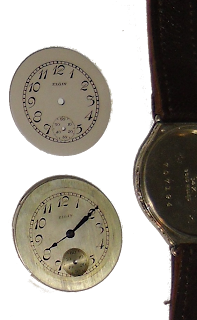Not too long ago, I purchase an “antique” Elgin wristwatch from the 1914-1917 era. I happen to have NOS dials for it. It had a 6/0 movement. I had this movement sitting around for years and I needed parts.
 After the watch arrived, I removed the bezel and found a Fahy case with a Hamilton inscription. Immediately, I felt “had”. I thought that this watch was a “frankenwatch”.
After the watch arrived, I removed the bezel and found a Fahy case with a Hamilton inscription. Immediately, I felt “had”. I thought that this watch was a “frankenwatch”.
 |
| Click to see blow-up of photo |
That wasn’t the situation. In 1927, people chose their case and face and then indicated the movement they wanted – or the jeweler suggested one. The Elgin had a 6/0 movement and face and it fit the Fahy case perfectly. The practice of matching a case, face and movement was a common practice. It originated with the way Pocket Watches were sold.
In the photo to the left, I place both the Hamilton and Elgin case. I showed two Elgin dials; the one on the top is the NOS dial, the one of the bottom is the original dial with the hands still attached and the movement still attached. The Elgin is a seven jewel movement and the movement that came Hamilton provided was a 17 Jewel 987. The looks are similar, but the Hamilton is the superior watch. It also cost more.
The photo on the right shows the difference in the dials close-up. Unfortunately, the camera does didn’t give a proper glimpse of the contrast between the two dials. The Elgin dial on the bottom is filthy. The one on top is prestine.
One other thing to notice between the case – the one that houses the Elgin doesn’t have a tube on the crown side. Someone filed it down to fit the 6/0 Elgin movement, stem and crown.
I don’t see anything wrong with the way the watches were sold. It looked a little strange at first.
Copyright 2006-2017 | All Rights Reserved
